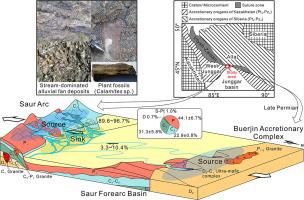Journal of Asian Earth Sciences ( IF 2.7 ) Pub Date : 2021-03-17 , DOI: 10.1016/j.jseaes.2021.104737 Yan Xu , Bao-Fu Han , Wen Liao , Ang Li , Chaodong Wu , Bo Liu , Hao Sun

|
Because of few reports on the Upper Permian in the NW Junggar terrane, Northwest China, the recently identified Upper Permian Zaya conglomerate in the Saur area can provide insights into tectonics and paleoclimate at that time. The succession consists of predominant composite cobble-pebble conglomerate (~80%) and subordinate (gravelly) sandstone (~20%), showing sedimentary structures of stream-dominated alluvial fans and the unique lithofacies in the Saur area. This conglomerate was originally classified as a part of Lower Carboniferous, but its youngest detrital zircon U-Pb age is 265.3 ± 1.7 Ma and the succession shows the deformational patterns different from those of the Triassic sequences in the West Junggar terrane. Thus the conglomerate was deposited during the Late Permian.
The Zaya conglomerate was unconformably deposited upon the Lower Permian volcano-sedimentary strata over the Devonian–Carboniferous Saur Arc (SA) and Saur Forearc Basin (SFB) on the northern margin of the Kazakhstan terrane, which currently juxtaposes with the Devonian Buerjin Accretionary Complex (BAC) on the southern margin of the Altai terrane to north. The contributions of the SFB + BAC and SA to the Zaya conglomerate are 89.6–96.7% and 3.3–10.4%, respectively. The conglomerate clasts are derived from Permian–Carboniferous volcano-sedimentary rocks in the SA, but the sandstones contain not only volcanic materials from the SA and SFB but also metamorphic and ultramafic detritus from the BAC. This is in support of the pre-Permian amalgamation of the Altai-Kazakhstan terranes. Plant fossils and organization of conglomerate would suggest a relatively humid paleoclimate with abundant rainfall.
中文翻译:

中亚造山带额尔齐斯—宰桑缝合带沿湿润古气候条件下晚二叠纪碰撞后河道冲积扇源—汇系统
由于西北西北准Jung尔地区上二叠统的报道很少,因此,最近在Saur地区发现的上二叠统Zaya砾岩可以提供有关构造和古气候的见识。演替过程由主要的复合鹅卵石砾石(约80%)和次要(砾石)砂岩(约20%)组成,显示了河流支配冲积扇的沉积结构和索尔地区独特的岩相。该集团最初被归为低石炭纪的一部分,但其最小的碎屑锆石U-Pb年龄为265.3±1.7 Ma,并且其演替显示出与西准gar尔地层中三叠纪层序不同的形变模式。因此,该集团是在二叠纪晚期沉积的。
Zaya砾岩不整合地沉积在哈萨克斯坦地北缘的泥盆纪-石炭纪Saur弧(SA)和Saur Forearc盆地(SFB)的下二叠统火山沉积层上,目前与泥盆纪Buerjin增生复合体并置( BAC),位于北部的阿尔泰山脉南缘。SFB + BAC和SA对Zaya集团的贡献分别为89.6–96.7%和3.3–10.4%。砾岩碎屑来自南半球的二叠纪-石炭纪火山沉积岩,但这些砂岩不仅含有南半球和南北半球的火山岩物质,而且还含有北半球的变质和超镁铁质碎屑。这是对二叠纪前阿尔泰-哈萨克斯坦地体合并的支持。









































 京公网安备 11010802027423号
京公网安备 11010802027423号